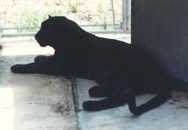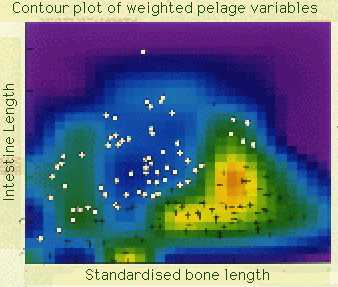- a unique geographic range or habitat
- a group of phylogenetically concordant phenotypic characters that can be described
- a unique natural history relative to other subdivisions of the species
- remain unchanged
- become extinct
- breed with another population and form a new mixed subspecies
- through population division, selection, and/or genetic drift become one or more new subspecies
- through isolation and acquisition of new genetic markers become a new species.
- Allen,J.A. (1919) Severtzow's classification of the Felidae. Bulletin of the American Museum of Natural History. 41: 335-340
- Balharry, D., and Daniels, M., (1998) Wild living cats in Scotland. Scottish Natural Heritage Research, Survey and Monitoring Report No 23.
- Collier,G.E. and O'Brien,S.J. (1985) A molecular phylogeny of the Felidae: immunological distance. Evolution. 39: 473-487.
- Culver,M., Johnson,W.E., Pecon-Slattery,J., and O'Brien,S.J. (2000) Genomic ancestry of the American puma (Puma concolor). The Journal of Heredity. 91: 186-197.
- Markie,G., Inglis,M., Crosby,P., Willis,B., and Smith,C.A. (2001) Scottish Big Cats. http://www.bigcats.org/
- Hemmer (1978) The evolutionary systematics of living Felidae: present status and current problems. Carnivore 1: 71-79.
- Janczewski,D.N., Yuhki,N., Gilbert,D.A., Jefferson,G.T., and O'Brien,S.J. (1992) Molecular phylogenetic inference from saber-toothed cat fossils of Rancho La Brea. Proc. Natl. Acad. Sci. (USA) 89: 9769-9773.
- Jardine,W. (1834) The naturalist's library: Mammalia, vol 2; the natural history of the Felinae. W.H. Lizars, Edinburgh.
- Mayr,E. (1940) Speciation phenomena in birds. American Naturalist. 74: 249.
- Mayr,E. (1963) Animal species and evolution. Harvard University Press, Cambridge.
- Mayr,E. (1970) Populations, species and evolution. Belknap Press, Cambridge.
- Nowell,K, and Jackson,P. (Eds) (1993) Wild Cats, Status Survey and Conservation Action Plan. IUCN, Gland, Switzerland.
- Severtzov,M.N. (1857-1858) Notice sur la classification multieiale des carnivores, spécialement des félidé, et les études de zoologie générale qui s'y rattachent. (Notes on the classification of carnivores, especially the felids, and associated general zoological studies.) Revue et Magazine de Zoologie 9: 389-391, 433-439; 10: 3-8, 145-150, 190-199, 241-246, 385-393.

Richard Of York Gave Battle In Vain
By Dr Christina A. Smith

England's Richard 'Crouchback' and Scotland's MacBeth were the subjects of plays by William Shakespeare. These were brilliant dramas, but travesties of history in which good kings were turned into monsters for political ends. History should always be taken with a good pinch of salt as it is generally written by the winning side! The ditty in the title of this article is used to remind children not only of the wicked duke of York who reputedly murdered the Princes in the Tower but also of the order of the colours of the rainbow: red, orange, yellow, green, blue, indigo and violet.
 But what does this have to do with Scottish Big cats? Well, one of the subjects of debate is whether the cats which are seen in the UK are leopards, pumas, lynx, jaguars, wildcats, feral cats, or even a previously undescribed species of native British cat? While this debate continues to rage, it is worth remembering that the division of animals in to species is rather like the division of the spectrum into primary colours, secondary colours, shades and tones - it is all a question of perception. While it is quite clear that red, yellow and blue are different, when we look at the different ends of spectrum, red is not the complete opposite of violet, but actually runs into it. So where does one draw the lines between the different colours - or the different species?
But what does this have to do with Scottish Big cats? Well, one of the subjects of debate is whether the cats which are seen in the UK are leopards, pumas, lynx, jaguars, wildcats, feral cats, or even a previously undescribed species of native British cat? While this debate continues to rage, it is worth remembering that the division of animals in to species is rather like the division of the spectrum into primary colours, secondary colours, shades and tones - it is all a question of perception. While it is quite clear that red, yellow and blue are different, when we look at the different ends of spectrum, red is not the complete opposite of violet, but actually runs into it. So where does one draw the lines between the different colours - or the different species?
Species of cats are like colours. While most small children could tell a lion from a tiger, few adults could easily distinguish a jaguar from a leopard, and even eminent scientists disagree whether the Iriomote cat is the most endangered species of cat or merely an island subspecies of Leopard cat. The classification of cats over the past 150 years has caused much confusion with conflicting systems being used concurrently by different authors. A major problem is that taxonomy involves sticking labels on subjects and requires dividing lines to be drawn somewhere. Taxonomy seeks a simple black & white solution where in fact there are often many shades of grey. Phylogenetics, on the other hand, studies the relationships between different organisms.
To take another example, there is little doubt that postcodes are highly useful aids to experts (in this case the Post Office) for determining the geographical location of a house. However, your house could be identical to the one next door, but have a different postcode simply because that is where the Post Office has decided to draw their boundary. By looking at your postcodes (the equivalent of taxonomy), someone might conclude that your house was in a completely different area from your neighbour's, while if they looked at the distance between the houses (the equivalent of phylogeny) it would be obvious that the houses were adjacent. Postcodes are incredibly useful labels for the Post Office, but they have very little relevance to real life. It should always be borne in mind that species and subspecies are merely the taxonomists' version of a postcode.
Definition of a species and subspecies
The Biological Species Concept (BSC) was defined by Ernst Mayr in 1940 and refined in 1963 and 1970. The BSC defines a species as "a group of actually or potentially interbreeding populations that are reproductively isolated from other such groups". The definition was updated to acknowledge that species generally occupy distinct ecological niches. Reproductive isolation can also produce population subdivisions or subspecies (e.g. on isolated islands) which can still freely interbreed with other members of the species but which have developed their own distinct characteristics.
Scientists are no different from the rest of the human race who enjoy seeing their names in lights and it is always much more interesting to say you have discovered a new animal rather than one which is already known. In the distant days of Empires, it was traditional for men of science to voyage to the colonies, discover a "new" species or subspecies and have it named after themselves. Nowadays, it is generally agreed that far too many subspecies of cats were described based on unconvincing evidence, and in 1992 it was recommended that no less than 235 of the 259 recognised subspecies of cats be re-evaluated.
With the application of modern molecular biological techniques, the relationships between different animals are becoming clearer. Classically, a subspecies was defined as "a geographically defined aggregate of local populations which differ taxonomically from other subdivisions of the species." but more recently O'Brien and Mayr have suggested a more realistic definition;
That members of a subspecies share:
O'Brien and Mayr also concur with the important idea that a subspecies is dynamic rather than static and that subspecies can:
The puma

This study is excellent news for the endangered Florida Panther (previously known as Puma concolour coryi) of which less than 100 animals survive, as these animals can be bred with other North American pumas without fear of contaminating the Florida panther with the genes of another subspecies. An infusion of new genes will undoubtedly act as a tonic for this highly inbred population.
The puma and the cheetah - long lost cousins?
 Many people still believe that the cat family is divided into the small cats, the big cats and the cheetah. However, the evidence against this dogma is now convincing. The dramatic changes in the perceptions of relationships between different members of the cat family over the past 200 years can be demonstrated by following the taxonomy of the puma and the cheetah.
Many people still believe that the cat family is divided into the small cats, the big cats and the cheetah. However, the evidence against this dogma is now convincing. The dramatic changes in the perceptions of relationships between different members of the cat family over the past 200 years can be demonstrated by following the taxonomy of the puma and the cheetah.
Jardine's classification was also reviewed independently in 1867 by Gray who was unaware of Severtzov's publication in the French language. Gray placed the cheetah on its own in a new genus as Gueparda jubatus, while the puma was placed in the genus Leopardus along with the leopard, jaguar and the African golden cat.
These two different systems of classification continued to be used, causing a great deal of confusion, until the Felidae were reviewed once more by Pocock in 1917. Pocock created three new subfamilies - the Acinonychinae in which he placed just one genus and one species, the cheetah, the Pantherinae for the big cats which roared, with all the other cats being placed in the Felinae subfamily. Within the Felinae, Pocock restored the puma to its own genus as Puma concolor.
Pocock's divisions are still followed more or less to this day. One of the most recent reviews, by Wozencroft in 1993, continues to place the cheetah as the sole species of the subfamily Acinonychinae while the puma remains with the smaller cats within the Felinae subfamily.
However, Pocock's 1917 analysis was purely a classification and he did not study the relationships of the various cats, while Wozencroft's conclusions in 1993 were not original research but a review of 200 years of literature. Recent research using modern molecular methods challenges the idea of splitting the cats into the Cheetah, the big cats and the smaller cats.
The first person to publish a phylogenetic tree of the Felidae showing the relationships between the cats was Hemmer in 1978. While Hemmer isolated the cheetah as Acinonyx jubatus, he saw a close relationship between the puma, Puma concolor and the jaguarundi, Herpailurus yagouarundi, as Jardine had reported in 1834.
In 1985 there was a major departure from the dogma of a Felidae family containing only the genera Felis, Panthera and Acinonyx when Collier and O'Brien published the results of their immunological studies. This placed the morphologically specialised cheetah in the midst of the medium-sized cats! Collier and O'Brien's research was confirmed by Herrington in 1986 who also considered the cheetah, jaguarundi, manul and puma to be closely related and placed the cheetah well within the Felidae family, rather than as a distant relative.
In 1993, mitochondrial DNA analysis by Janczewski et al revealed that the cheetah's closest living relative was, in fact, none other than the puma! Stephen O'Brien has commented "Earlier taxonomists had largely ageed that the cheetah's adaptive specialisations for high-speed sprinting merited seperate generic status and likely indicated an early divergance from the felid evolutionary tree. The molecules did not agree."
The Onza - a missing link between the puma and the cheetah?
The following is reproduced from The Catamount Vol. 2 Number 2 February 2001
WHAT IS AN ONZA?

It sure looks like an odd subspecies of cougar, doesn't it? A lot of people say that's what it is. But there are some remarkable differences, especially when you consider the accounts of the species handed down since the days of the conquistadors.
This female was dissected in Mexico in 1986. She had coloration like a puma except for the horizontal stripes on the inside of the forelimbs. (Peter Jackson has reported "Faint horizontal stripes may occur on the upper forelegs." in the puma. Chris Smith). The tooth pattern was somewhat different from the Puma, the body is much more slender, and the legs while longer had much more sturdy bones. The non-retractable claws seem to indicate a cursorial hunting style close to that of a cheetah. It is noteworthy that the cheetah is the closest living relative of the Puma. The paws are also narrower and more elongated than those of a puma.
The Onza seems to be confined to the Sierra Madre Occidentale mountain range in Sonora and Sinaloa Province in Mexico. It only occasionally comes down to the lowlands, and the rugged terrain where they live is impassable to vehicles and nearly impossible for riding on horseback.
Little is known about this cat other than it eats deer. It is also said to be faster and more aggressive than either the Puma or Jaguar, and the locals are more afraid of it than any other native cat.
These are not the only rarely-understood carnivores out there. In Great Britain there are many people who swear they have seen a mysterious large black cat which appears to be a melanistic puma. This cat, also referred to as a "Catamount" (amongst other names) may have been released by an owner when a ban on exotic cats swept the isles. However there are many people, some armed with evidence, that claim the mystery cat is a yet undescribed species, possibly the European cousin of the puma.
The study of animals not yet proven to exist is called "Cryptozoology." The most famous subjects of cryptozoological study are Bigfoot, the Yeti, and the Loch Ness Monster. However, as with the Onza, the subjects of cryptozoologists are not always so far fetched. So what is the Onza? You decide.
The Scottish Wildcat

The accompanying figure is from a study of wild living cats in Scotland by David Balharry and Michael J. Daniels. They studied intestine length and bone size from a number of wild living and domestic cats and plotted the results. In a single population, it would be expected that smaller cats would have small bones and short intestines while larger cats would have large bones and longer intestines. In this case one would expect the points representing each cat to be more or less in line from the bottom left (small bones, short intestines) to the top right (long bones, large intestines). From the plot it can be seen that this is not the case. There are a number of cats in the bottom right of the graph, which are large cats with short intestines. These were defined as "group 1 cats" while the others are defined as "group 2 cats". Group one cats are presumed to be the closest to pure-bred wildcats. However, the two groupings overlap considerably due to cross-breeding between wildcats and domestics and it is clear that there is continuous variation rather any distinct differences between the various specimens.
 Some cat enthusiasts blame studies like the above for the continued persecution of wildcat. One of the authors of the above study was an "expert witness" in the 90's Stonehaven wildcat trial. Because of his deposition that it was impossible to tell a true wildcat from a hybrid, the gamekeeper who was charged with killing several wildcats was acquited. The same witness is alleged to have stated recently that all tabby wildcats are "hybrids" and the only true wildcats left which conform to the ancient type are the black "Kellas" cats. Some believe that such statements will do wildcats more harm than any gamekeeper ever could. The expert opinion in the trial gave gamekeepers carte blanche to kill as many cats as they could, and the hybrid theories effectively remove tabby wildcats from the protection of the law.
Some cat enthusiasts blame studies like the above for the continued persecution of wildcat. One of the authors of the above study was an "expert witness" in the 90's Stonehaven wildcat trial. Because of his deposition that it was impossible to tell a true wildcat from a hybrid, the gamekeeper who was charged with killing several wildcats was acquited. The same witness is alleged to have stated recently that all tabby wildcats are "hybrids" and the only true wildcats left which conform to the ancient type are the black "Kellas" cats. Some believe that such statements will do wildcats more harm than any gamekeeper ever could. The expert opinion in the trial gave gamekeepers carte blanche to kill as many cats as they could, and the hybrid theories effectively remove tabby wildcats from the protection of the law.
The law fails to understand basic biological concepts. Bacteria normally multiply asexually and generally each bacterium is more or less an exact replica or clone of the cell from which it derived. Animals, on the other hand, reproduce sexually, requiring both a mother and a father. The offspring will be a mixture of genes from the mother and the father and may resemble one or the other, but will be identical to neither of them. Genetic variability gives animals an immense advantage as it allows the species to evolve and adapt in the face of changing environmental pressures. Anybody who has been involved in breeding dogs can vouch for the fact that mongrels are generally healthier animals than expensive pedigree dogs with their canine equivalents of the Habsburg lip. Just because some Scottish wildcats have cross bred with domestic cats (themselves derived from wildcats) should not diminish their stature. In the end, we are all mongrels, and the world is a better place for it. Vive la difference.
Further reading
 |
 |
 |
| Return to index | Return to Scottish Big Cats | Return to Wild Cats |